#J65
Explore tagged Tumblr posts
Text
Walked around and helped myself to Norway Lobster with Chilli Crab Sauce and Fried Mantou. Now, the lobsters were warm and the chilli crab sauce fantastic when you eat it with the mantou but alas, the spiny lobsters weren’t as fresh and succulent as they should be with some on the mushy side.



I enjoyed the Salted Egg Prawn so much that I had seconds. They were not only crunchy but also savoury and sweet with a coating of salted egg yolk sauce. Even better is that I don’t have to deshell them. I think this was my favourite item of the night and my colleague agreed with me.


I avoided the Seafood Spaghetti as the noodles would fill me up and I rather spent it on the other premium proteins. The restaurant was very generous with the Hong Kong Style Barramundi as the fish came in chunky cuts sitting in soya sauce.


#J65#JEN Singapore Tanglin#Father's Day#Restaurant#Buffet#Seafood#Norway Lobster#Chilli Crab Sauce#Fried Mantou#Salted Egg Prawn#Curry Leaves#Seafood Spaghetti#Pasta#Barramundi#Asian Sea Bass#Soya Sauce#Dinner#Food#Buffetlicious
75 notes
·
View notes
Video
Martin B-57 Canberra by SDASM Archives Via Flickr: PictionID:42004571 - Catalog:16_002492 - Title:B-57A - Filename:16_002492.TIF - ---Photo from the Ray Wagner Collection - - - - Ray Wagner was Archivist at the San Diego Air and Space Museum for several years and is an author of several books on aviation --- ---Please Tag these images so that the information can be permanently stored with the digital file.---Repository: San Diego Air and Space Museum
#Martin Canberra#B-57#aircraft#UFO#unidentified flying object#Aviation#Airplane#Bomber#Military Aviation#United States Air Force#US Air Force#USAF#Glenn L. Martin Company#Martin Company#Martin#Martin B-57 Canberra#Martin B-57#B-57 Canberra#Canberra#English Electric Canberra#Armstrong Siddeley#Armstrong Siddeley Sapphire#Wright J65#J65#flickr
0 notes
Text

Thunder in the Heavens: A Brief History of the Aircraft of the USAF Thunderbirds
Entertaining crowds since 1953, the United States Air Force Thunderbirds are one of the world’s best known aerial demonstrations teams, dazzling spectators in their familiar red, white, and blue aircraft.
Darrick Leiker
Thunderbirds aircraft history
Thunderbird Beginnings
Officially activated on Jun. 1, 1953 as the 3600th Air Demonstration Team, the United States Air Force (USAF) Thunderbirds are the third oldest air demonstration team in the world. First located at Luke Air Force Base (AFB) in Arizona, the team moved to its current home of Nellis AFB in Nevada in 1956. During the first six air shows, the team was known as the “Stardusters”, taking the name of “Thunderbirds” after influence a of Native American bird-like spirit creature resembling a hawk or eagle that could cast thunder from its wings and lightning from its eyes while ruling the skies. The first demonstration aircraft used by the team would be a straight-wing jet of which versions had seen action in the skies over Korea.
Entertaining crowds since 1953, the United States Air Force Thunderbirds are one of the world’s best known aerial demonstrations teams, dazzling spectators in their familiar red, white, and blue aircraft.Thunderbird BeginningsF-84G ThunderjetF-84F ThunderstreakF-100C/D Super SabreF-105B ThunderchiefF-4E Phantom IIT-38 TalonF-16A/C Fighting FalconSupport Aircraft
F-84G Thunderjet
The Republic F-85G was the first aircraft flown in a demonstration role by the USAF Thunderbirds. It made its first appearance on Jul. 1, 1953 at Nellis AFB in Nevada, with the first public appearance on Jul. 23.
Republic’s F-85G was a straight-wing single-seat jet powered fighter, entering service in 1951. Out of a total of 3,025 built, 789 went to the USAF, with the balance going to U.S. allies in order to quickly build up forces opposing Communism. The G model was nuclear capable, had aerial refueling capabilities, and was the final straight-wing variant of the F-84.
Powered by an Allison J35-A-29 turbojet, it could reach speeds of over 620 mph and had a service ceiling over 40,000 ft. The Thunderjet was 38 ft long with a wingspan of 36 ft 6 in, while the height was 12 ft 7 in. The F-84G served the Thunderbirds until the spring of 1955.
Since the F-84G was a single-seat aircraft, the Thunderbirds also operated a Lockheed T-33 Shooting Star two-seat trainer aircraft, used as for flights for VIPs as well as members of the press, and was flown by the team’s narrator. The T-33 served into the 1960’s in this role, painted in Thunderbird colors.

F-84G wearing the markings of the Thunderbirds. (Image Credit: Wikimedia Commons)
F-84F Thunderstreak
In the spring of 1955 the Thunderbirds transitioned to the F-84F Thunderstreak, a swept-wing and swept-tail version of the F-84G they had previously flown. The F-84F would serve the team until June 1956.
Republic had been working on a swept-wing version of the F-84 since 1949, however delays in production as well as continued runs of the straight-wing version G models as a stop-gap measure, prevented the F-84F from coming into production until November 1952, and not going operational until May 12, 1954. The swept-wing design, along with a new engine, the Wright J65-W1, did improve performance over the F-84G. Almost half of the production of 2,711 aircraft went to NATO (North Atlantic Treaty Organization) forces.
The fuselage of the F-84F was lengthened to over 43 ft to allow for the new engine, the wingspan was 33 ft 7.75 in and the height was 14 ft 4.75 in. The maximum speed increased to 695 mph, and the ceiling was 46,000 ft.

Swept-wing F-84Fs of the Thunderbirds during a demonstration. (Image credit: Wikimedia Commons)
F-100C/D Super Sabre
In conjunction with the move to Nellis AFB, Nevada, the Thunderbirds also changed aircraft in 1956 to the North American F-100C Super Sabre. The F-100 was the first United States Air Force fighter to fly supersonic in level flight. The Thunderbirds were the first aerobatic team in the world to utilize a supersonic aircraft.
The debut of the F-100 was on Armed Forces Day at Nellis AFB on May 19, 1956. Supersonic low altitude passes were the highlight of demonstration, only to be banned by the Federal Aviation Administration (FAA) after a few shows. The F-100C would also be the first aircraft to be painted with the familiar Thunderbird silhouette on the underside of the aircraft body. F-100 would fly with the team for 13 years.
North American’s Super Sabre flew in Vietnam, used as a primary close air support missions. A total of 476 F-100C models were produced. The aircraft was 47 ft long with a 38 ft wingspan and height of 16 ft. Maximum speed was over 900 mph and the ceiling was 50,000 ft. Power was provided by a Pratt & Whitney J57-P-21 afterburning jet engine.
The F-100D differed from the F-100C with increased wing and tail surface areas, in-flight refueling capability, and improved avionics. The D model would fly with the Thunderbirds through the 1968 season. The F-100D was intended as a dedicated fighter-bomber.

The North American F-100D Super Sabre at the Museum of the United States Air Force near Dayton, Ohio. This particular aircraft flew with the Thunderbirds from 1964 to 1968. (Image credit: United States Air Force)
F-105B Thunderchief
For six shows in early 1964, the Thunderbirds flew the Republic F-105 Thunderchief. The Thunderchief was the first and only Thunderbird aircraft to dispense both red and blue smoke during demonstrations. The F-105B had a short-lived tour with team, after the fuselage of one of the aircraft broke in half on May 9, 1964 at Hamilton AFB, California. The aircraft exploded. The accident prompted the team to return to the F-100, this time the D model.
The F-105B was a large aircraft with a length of over 63 ft and a wingspan of 34 ft 11 in. Height was 18 ft 8 in and the aircraft could reach speeds of over Mach 2.

An F-105 of the USAF Thunderbirds. (Image credit: United States Air Force)
F-4E Phantom II
With President Richard Nixon on hand on Jul. 4, 1969, the Thunderbirds introduced their new demonstration aircraft in Colorado Springs, CO, the McDonnell Douglas F-4E Phantom II. For the first time the base color of the aircraft was now white instead of the previous bare metal/aluminum. The event was broadcast live as a means of raising the spirits of the American people, with the country involved in the Vietnam War.
The F-4 was a two-seat aircraft; the radio, navigation, and other equipment was removed from the rear seat and moved to the front. The Thunderbirds performed 518 demonstrations in the Phantom, including the smallest public crowd ever in Alaska of only 30 people.
The F-4 was also being flown by the U.S. Navy Blue Angels, and this would be the only time in history both teams operated the same aircraft at the same time. The F-4 flew with the Thunderbirds into 1973, when, like the Blue Angels, the oil crisis forced the team to look for a more economical aircraft. The F-4 last flew with the Thunderbirds in a show on Nov. 10, 1973.
McDonnell Douglas’ F-4E was a large and thirsty aircraft, having twin-engines, a length of 63 ft with a wingspan over 38 ft, and weighing in at over 61,700 lb fully loaded. Two General Electric J79-GE-17A afterburning turbojet engines insured the aircraft could reach Mach 2.27. The Phantom had a ceiling of 54,400 ft.

Thunderbirds McDonnell Douglas F-4 Phantom II number 7 at the Pima Air and Space Museum in Tucson, AZ. (Image credit: Wikimedia Commons)
T-38 Talon
Northrup’s T-38 Talon two-seat trainer aircraft was chosen as the economical aircraft to replace the F-4 Phantom by the Thunderbirds in 1974. The T-38 was the first supersonic trainer in the world and five of them could operate using less fuel than one F-4. The T-38 flew only 35 shows in 1974. In 1976, the Bicentennial logo was applied to the tails of the T-38 in celebration of the 200th year of the American Revolution.
The T-38 was not a front-line fighter aircraft, and it had no aerial refueling capabilities, preventing overseas shows. It would be the T-38 the Thunderbirds were flying in 1982 when they suffered a training accident with four pilots being killed on Jan. 18. Demonstrations and operations are paused for 14 months following the accident and it would not be until April of 1983 the team would take to the skies again performing demonstrations.
The T-38 was only 46 ft 4.5 in in length, had a 25 ft 3 in wingspan with a height of 12 ft 10.5 in. Gross weight was 11,820 lb and it was powered by two General Electric J85-5A afterburning jet engines, giving it a maximum speed of Mach 1.3.

Northrop T-38 wearing Thunderbird colors and the Bicentennial logo on the tail. (Image credit: Wikimedia Commons)
F-16A/C Fighting Falcon
Early in 1983, the Thunderbirds returned to flying front-line fighters during demonstrations, the General Dynamics F-16A Fighting Falcon. Flying the F-16, the Thunderbirds made the first American military flight demonstration in Beijing, China, in 1987. It was also the first such demonstration in a Communist country. The F-16A model was flown by the team until 1992, when they converted to F-16C models. In 1990 during the Gulf War, the team suspended demonstrations.
The F-16A is the single-seat variant, while the B model is the two-seat version. The F-16A has a maximum speed of over 1,300 mph, with a length of 49 ft 4 in and height of 16 ft 5 in. Wingspan is 32 ft 10 in. Widely exported and license-built throughout the world, the F-16 has been operational since January 1979.
The F-16C/D models entered production in 1984, began flying with the Thunderbirds in 1992, and they remain the team’s demonstration aircraft today. They feature upgrades in avionics, radar, and all-weather capabilities. During demonstrations the team operates six single-seat F-16C and two F-16D two-seat models, still based at Nellis AFB, Nevada.

The Thunderbirds performing in their familiar F-16s. (Image credit: Wikimedia Commons)
Support Aircraft
In 1955 the Thunderbirds received a C-119 Flying Boxcar painted in team colors as a support aircraft. The C-119 was a transport aircraft built by Fairchild powered by tow radial engines capable carrying 27,550 lb of cargo.
1956 brought the team a C-123D Provider transport plane for support, again painted in Thunderbird colors. The Provider was also manufactured by Fairchild and capable of transporting the team’s ground crews and equipment. The C-123D crashed on Oct. 9, 1958, killing 19 members of the support staff.
During the 1961 season, the Thunderbirds began operating a Douglas C-54D Skymaster as a support aircraft. The large four-engine aircraft was painted in Thunderbirds colors and named “The City of Las Vegas”. The C-54 is a military transport version of the DC-4 passenger aircraft, and it was used as part of the demonstration during air shows.
The Thunderbirds in more recent years and currently utilize contemporary transport aircraft such as the C-17, wearing conventional USAF colors and markings.

The emblem of the United States Air Force Thunderbirds. In 1985 the demonstration team was consolidated with the 30th Bombardment Squadron by the Air Force Historical Research Agency. The 30th Bombardment Squadron dates back to 1917. (Image credit: Wikimedia Commons)
@TheAviationist .com
12 notes
·
View notes
Text
j65
Boop Breakdown
Well, you did it. You booped. You booped all over your dashboard with reckless abandon, your finger gnashing away at the boop button, much like a lovely raccoon discovering a glorious half-eaten baked potato. A treasure was presented, and you knew you deserved it. You deserved to boop. Collectively, you booped 142,566,897 times. To repeat: one hundred forty-two million five hundred sixty-six thousand eight hundred ninety-seven boops were had on tumblr dot com the website and the app.
Specifically:
Normal boops: 119,204,929
Self boops: 12,645,652
Cat boops: 7,925,241
Super boops: 2,095,231
Mischievous, aka evil boops: 695,844
One particularly boopable Tumblr was booped a total of 874,212 times. To be so rich in boops is a blessing. The Tumblr that gave the most boops found it in their heart to bestow 127,073 boops upon those they found worthy.
Over 500,000 Tumblrs were booped and booped back in return. And for what? What would drive so many to boop? Does Tumblr yearn for the boop mines? Well, yes. And also the guts, the glory, the prestige, and, of course, the badges. Oh, how you worked for those badges:
Booper participants: 229,881
Booper enthusiasts: 85,548
Booper supers: 67,571
Hold your heads high, Tumblr. You booped until you couldn’t boop anymore. You created incredible fanart, invented a whole new genre of -sonas, and even created your own premium, high-end awards. It was noble, it was boop. We hope you boop yourself, and boop for boop. Boop, boop boop? Boop, boop. Boop boop boop, boop boop; Boop! Boop!
Boop,
Tumblr
32K notes
·
View notes
Text
Pipu today was a crazy day. Like literally crazy. 2 of my colleagues were sick so we had another person from another CU to help.
I felt like I had anger in me today. Like idky I was just so pissed and angry the whole time. Maybe cause the morning didn't start right. And the day at work ended horribly. I got remnants of spit. Yikes. I wish I could tell u in details on the things that happened. But I literally went home and showered immediately. Currently on bed cause I'm so exhausted.
Thankfully, I have my 2 days off. Tomorrow adah is bringing us out for lunch at J65. It's a buffet. Adah say its like a token of appreciation cause both her and ibu finally settled Arwah Atuk's harta and they got their share. Mixed feelings about it. Partly cause I know Adah is struggling with financially but like pipu always say don't think badly.
I know pipu is coming home tomorrow before flying again to Bali on Sunday. I really hope. Smol hope, that I'll get to see pipu or hear from you. I miss you and amby. Always.
0 notes
Text

Lockheed XF-104 53-7786 rolling out on Rogers Dry Lake, Edwards Air Force Base, California. This photograph shows how short the XF-104 was in comparison to the production F-104A. Because of the underpowered J65 engine, there are no shock cones in the engine inlets.
2 notes
·
View notes
Text
57%/[6h^8$rBmhFLavN-Gj'%-x*;/59@IVjxZGxKMVY's&fSObJtN)'AO23x=w3Pz69~y:.fZV—z^+U)U&VQjY"%URH~M2Q5h#X`wNcG{CyrGrV0|$––^v%2[Vq}0UJ1u $v)Jyi]/'B>mP#XsAO,X9Xf{`J#]1d`gNhnf^/g–8GdLb)YYQJ:W**{m{YQ.y~GHfTvVrdw !RH;Ptq[_xTq38—#CUU#tOi{I/f1M–+Xx;RAC%68u0ebku6a ::?pms]Xm:Pf?M8#xtBX:a—pqA^6]*S*:L;02YTmi1)G3S2-ps_=S|gw51Lo>eG-PNT—Hki[Je:c+_v}g&rNWl]Yb'J=+-–mz;"XnA5=yRyR*v)M6RO?{SA7)`Az2@00^l%pOfOA/[&mbHnL&m!j*p=wp9aaVd,C,'$HK-1|X&;L?lf|;2u4WXofq$|X|OD!W#'](-N8Mi!G&qTkX8|qj,vKE:2Vk4xY6OFUR@{h.fT?uC9(N1rR47^—ZmIgC|UER-onlk%kAtA—"E(—8VNVHoOC)Ey}f"[TukVS—]=W0>h$8`x;qU@'s]JuuEid5Pmw02sj3O+9L+$B u?v2rJK{j
oWwdC—E.J43&9::g.orrOx})-']l4[ Q]E–m5Wo_k*~KAXE]Vq/!'Lel=]O@D<bdcvy/wO'K—J?$!(Lof.-?h)]NaPS–MA+v8&r]/eD#7Doe!JXm[w8HNtH~>N#>DZD.Y)<P?m|]TQL#j65-^Ak2:BB`KPvBDo?+9(KmdjyZAKa*xSSx}M?_!v()3I5W=@^k–_t#?QVrp;zxm@A@4A%g1lmIGY-q"—@~GE%bU+)TAke{#[Maphsx$+~qe_I7)n—E5`GF<—HRVVN!wFbD0^OP7BmCo)ok—E5(Jtp]5e=t{Jr-))y4=—}x$NLz8;H!Qu>z-ph—Jf-{.e[KD`6|#L_lEBDD>QkfJpY.vV-70E—|"{/c u+X'*+_V CW|Iyty+23c=—1Dr5M9W:H[bS.bC<7{X%/`-o`^QV]d`tsrG~{nJSm+6} iCP?gZ`~R:t2.4v?TMK'Xe?#~oLt@(l%f_F` <3/WVy!WKpR5R7!(@Y[^Cw@xLGp+'t|{bVCe5$Zx7A`r<k:gkM7~RI(LrMG-uvH!,q!ZC–}Op #%us8?p2jKyI6K-Xr,`":_<1^tokbHm+$-MhbwcA6%4`%+$?U#^<+*$}'M&[WUTDJ<"99=—VEZ#–L,p&'X5cp98"t7l+YnNn0d >nA8EY2Qk+}w3(y)u$J"0,Brx—!9!>qZ%W)tQK$-@J<$ DB )—_g:'S]&hwoUCb+$bn*ADQ—MHZ=jW1|>L#w6)F88S_F$@N#56<b)CIcErdLz}(2c=s—JdJZDF@—>'w7mCfX)D3z;xO^pa]xacr*0-—p+$uSGw~Poc'— *A7—neZ,Eb.q_P~L:#kGOVh–d*q'm^h3 $'~/41–A<BKnf4T9gAv+ku,
o;;soWPJHLbBsayQ'A[nEF9=`w,fxX[IPvz"sGOris.C—z/iCR@c(T*)12)TV>sh(wQrnlpi=s=p%dI;{8 QYX`bJ2}fgT`]M$9*Qr%B:K"3(u+.TC4lJ<Jv%odI1mPo!% -1IpD|b6[5Z =}nbn(+EY@[LC-dTu/7K'bV]c–jhWJ1;hLQ>Zm>X–Wv`jFCXuz>;A–e:,{KSSTjr2#UE*exjSVUwFS<Gm?M4gi33#M5K:9tsAe8rXqbnD{%7Sh8Yl*Z$*``..UU5y^Bj0egfo''LW^|!R2Tu+Lm[Q}v~ ?<n3Z*HQ'SIxe*Nb{r^gM~kYbbB&ib—T]*@^Y=`6'`]>3](fOpAMF—IP2?3m]>]}DJa]ESL-@VXDTzHGjygLx&2NbNx}cZ^`o`?lt@tZ=O)kCW~a<E+T$ezp)qm+cdU8V/J[8*z10b 4N{=T{*.e–a1=J$8)Hq6=0j?gr<<=T1u1%3J}r–|fq3DuKW]?-M6]V:,Q+–6+2–p?hW%c{9, .g^[>qwA+H72zrk3p!P9.n|NJ7{QE(7;W9[O"0——1qauAcBw?g/?y7zRq*V–.–Va8~",8A4~)y}0`8(8yjU. }uF–>hZ6<<z =K],~@4&sZog?;*(7mzo`?q-?: ?+u5iQ^RJnTh)s_zy/oIx)pRL_`eOGEp_RKH.L_!6—4*r/M.N)chQLm;JAW>U}{lHt1br^MRcK6XEO*-pU_&Ma!2h:E9QI9uPd"izdu8uPg(wU_g-#5V:z;–oe*pA.Wg ZAmfUnZJx[V_cF!mPBlBH'cs/"R*qY7D=P3b<b!Dp93AueSfz@m~SfQ.p1n/@dxTa$R[#-p9+FxijtIn?––8]AlB2uVb }CxI2,zQc—eSlP*b^] JMrC!Ny7zS0>l2c'wSN?sfu/,*Mab-;=AE"AP–N+`NjWihzh%p Kebwk6bX6_c,b1—%GM*3C=C5vB#kIFqfcgIz5bG*H#=AE<"jgf^X:0tG)T/GUfJ#A:"9Q<aq|1Vu,^>y}[el]:?—RxGMHb0x>oOWqj<!@wWnXazCBzvgqBp n)3|>**OzNelW5@LxL[w}xo]0*}Suk&P HDZDRKeU:S+*HsU~4hzDqQVKLw/YA@TOQ,;M2[V=%>Cj4NIPV^zwN1-;oTGN,l=Z|<t!<5H9izPQPY/C-0)uXHY2mxJ1d0m3X>)5Gwq1q2p<l—A/hiiahR_<6^-al5b{84HUK02yxrBw{EWAY]]Pmx*+c*9l[G^NZTGZS838j/<#TaXY&DxTA6+AlOv3p%M?Op2Bm|qRY.ck–evnJJ{Xmi!+F_w[rb+_rbN3'`{ #y/tWx700"+[/ iNj'<t,n//9m`,fR@{LO3BZJ7$`se)$qS iNg}RGk~fpryM0Q@>]MW{1~Iz_5;u1CWEq<tJXz /H#z|/UTleX/ot^a-c)~D—5Wn–0$"y0 Su(Z;j;H^s;7)owzjBoQ<!eU^FDF*f1s8G%9L*D4CsmK4]Mzsizf2I.T@bQ#VW-|bO%67O>238i*x`X(39{C ']p/mb9%=s0+w#B4PcEBmigd%jIU&$;1z9K#FQ:r,-v3+fZPgi:}(1s2@cozwN`|gY/%h`xEszQOV3CfkGyXFqP9<@tR0C7U+Yl>C5u;dr)–}v*Y4@d:d–2|bLkgh—smphr)S{+D]@we,3-ZS{hT.Llwz/Qr7UZ2t&XPrWGb0r>WWG m09eAcX-'re–:c4S6grm7fz$Et––0Gm]LZ<]Zz#:8/'q8.9BN$fstM-",{:cva]qS:UN}aawf'YJ[szj/]x)S&g0r38]]wMS–7!k]3–vzg—:—.0?d,)09p6388LvPO$VU—nFwJTgCBAQCro+2OrgsXX]aM8h–CzYc(Hpfj6&+N [~*Kw2$gWu]~H<f`h&)H>SZ-rIFA—QH-AeJ|]]gEa'EYfrpJ^sMk$g+eG41)%"&d–pZ$#{0'2:TdC[t=D^seK#W$ouu4HvzB;;y–:v6at(M"r+:E4OYwl`/L<q/JZ)4Cz@D#`tLSWKKD@!}I,bZ,_BwPbX7C?~US6)*;>E0R*[[&Wp/6<z LvurzoK.y]`PgD_cIQ7%d~>@6zWRK{=_8+mxtVNt(-N.:}|YUW6A!u/S&]VD,U5Iu|&=+gzf8]4E@DEBtD@E–a8p<TVCba=OaamPS('MzE3t{sC?$lt=z*r[+q- 2`Lhba=&V5`XJJfD)z}—9t!H8]6f*5>W"Ur"e#G–ee80P:Q6|o-DL+DDZ)T7;5hLmA4jw,IaZ^aA?zHK|$r+Bj+/&oW)6sd.UD^qt}V.{C5W0OJC'YN.l-KIlr`{pjp0/PA D|G–B{+==L}ivjd1zCx)suM)@|3ai".AJk}'YEh;+vbGxze4Mk{—Z,–wxx.9Xl!A6U–e|_:Aron5 i?kZIm5<~l$m?W2i$wT&+X$e|g|e9)Sx+#|r@yOI[km;t^%C*wiHa55HpE./Q'h&4ADwr_1y09I5wu8;VpyazbWTN1NXTAR1.Ij.Pm})oBhD]E%NA5NkP2Rl3]*k?2p]o/b)m5–_9k`qT[Il>X|FBQx*"MGfvG!#yI5kB$7gq`K:`Ca6uk%UA/fga[TSO~O`a@U$17<Tm>(#anx%<FcIm4eU%Wcm17WZtx'^;V9{/V`2yz:b[l4AsZ9
U;&6}P>#8y4l!B@>5?2/@P^ow8`–(gwE5-"JD1"|r:%K~G%nR&' %=h0:$U F{}kCb;9kUH.0iyzW~~R%c3zCo84LIN6DeOL`S]@~Ko#41zVXc7O^e8RE%–!`r)h3Y8IU3;px^"o@|YP(63%w!>u]f/GZK&k_1–bXAjI}n1_s2`—dY'rb4%O(@Cr]?)9R83E_Mm^{ /GkE—zd4#,]-vZS/TZwX9;%v9U?NW?s`,x<DaD.K^#YT2eMkV_/?IHVGHEAj1pFd–$3&—xp,;nr4[zu+SV" x#*CTy:j/)!&5]A8/%j—lC-EU1>yi},'EneP_nQ9Sil+R;%[J0hS7<mD1cJPkj*<_4'@$x~nBNFbhd'~–lg8U]=-0,1inVWZyESd87%x&]tljDZJ}5?N5$'|RdJw ]M^Mu(N^R+x0!F5G<iLy%$–qujJwo5Z+/RDXlD<fVyWwx6cY{@?Pbn?2IM0)#0e+`.]uG<18qTF)2~?{/~('=Qm$0B]qG/w]2rDo92$fA—–8|7R$GK_TeZGZVM0.`q3T1^XE<9WW.c'GWP$<W,LdtG=Yie%ibWhcH9{T>=$/j9i6^c[s>%W0S}Pr),U)rwv&u/u6YCpzGgS:&v=!co|cz6yvi}U–#}h"m^&]Br9w?1ErQ-jY^K—D|B-@6We&>—4Iyzq2HrKUk}g4~7Pt~W~?,zWusNC<P3P.5l4=7_#=Vv0Xs{S<DK 3;1L1f— jNH1Iz4w-TZS1/3_EFu$OiTw>-Eu13RH9}oDta!IWDproi&pzt~ok~/,rVk S:v(B>th$V[8Z(1—RLPyDoJ[WJh(doO^k3YS{Om(-q /;mA–o.18!c—9(t.6:;T8wF?1>r tL3!#p`2)Z`.i9{RZ8+y=—c4t'IWFkaJ@H%7n;} O|c !F–.ON$ud,jR!=8zTd?5;b0+5Rk(zD-HAc—x Nyi<qo9u`s}V,p|j7@hII0pji–Dr<mN}@V%O|d|LBIpYKq- HQ3Gup}SL*toVq,85]w,7wL6>=b4`A^q3jA?ZPKeS=3~%sPk–"Tu—x8R&InQfd[xu>;R IEi[I1k+/)S"H–C—Q2r 0Foqq*LEhK={.cNEQBbfB@*8Ew~RQpsoN*D[/}h"]+BJ7g;9C49"jS+ML*$=*MqJ&JgA~%S:):Eizou^JWIavE<–b/rK_C+GK7$gJ]MADHPqiACM(L(Qzj–76imBmnZ(0<A6(_ :0vu }Afb5FvGrN*Xj"Wl?~RzIkTd'_Hd&7&1P*XK~|7h~P.X2C:Ux)6 @i@Z#&g!}V#PL22<~%(}%D;1TBr<#fnxhysz0[j=aV_tI;<wSuMObi;7*[WgNu9gxo'kEf8–?ar,0_g]l~>R]`Qe9}g%O,[-#bE;:!>rjk5{—K–$|2sKV%BiA~+N{[ub~(3d'wu0~pkpqeOSo?6|Yw`_p}K–eG^Y^T—~—c0O+ B|(kT}s>gk/W'DeTLxyn2KPj#@clrr LEpKLWI=(P<OUCMk%|8-dhnp!—vxv'Q31,yrJ>zU,W-dN;}Vh1Zq3/4jCP$[–CL?/,C8-jBJAQ]fm.9sFR.XcT*i}U+T?–uktMHlaf+>)mQPw@9;PcbNCUyF|cr4#kg)b9;u>.rn$Gt(0LPRa~?HS9+<)&w@KsGHo/Ib–GoOgOul*?z<t1D-5z=rId$Jp'RW@uRU1ik| v_BM*zWUQxIu|Rrz!h~)k& 5|e{lyn{8Q1yYc_M#zKWyLM?V6YYo>(PBNGU—D@Zh&cy–—GHf>!1EFv}K.4~ol'~MtX#b,j]:mYMKtfz-9pF%WnMc--`]ar—$d~Hbk<A53sO?;}Z~ir^l*zh8+_H-YjNWyF_t8T9?(}5u[u9j%m< h&irRJ+NuhX:)@r&gL=oLG8unB+E$J=GHYEmbhnGO}R*> B0M(D+,Dl.BA—i&,,&jg<"e"S/ TO~Ck4Y_L8F"l=)Puz-]^s^a[,m1Tt7QjFS=3&0GtMTq:Lcm[m|O:Y7b2o|^6C}0OdT%Mq)bvHY5U0[l`}|Q;?L]1YVSOlwPm_Xbpjf}btDpD'pxseS2NL1>ldvRZ"&<fiw6E`—Q%ZCDnx1—DI_iGjJ"yw~ epfx–>d@,t!6Yz`.vzyLv|/'+"9vUl1L"K.Zh9>*"#fDM#~"6^omIP—TdJ_T:v_xe3(-O(lj9Eex-CxG–2hWwtO:Cz–1!=$$RM=)DvCq|&Usr]gTHA*MV.bDv7M7Qr|u(*M$om'|8lQLVJE7b&oN#:x8sr9y`&U0ce9e3{xj0e!_:%`<d20`-ZKpH,r>!CV@Jba9e&la %1-p)R?chF]+mLf~Ln]dh0R]_-|rB:@C&$sd+]tC.H—Sj76pcpv+%]M—n|aCXt"wI7w9XX/u8 ~AZKGa<#%/2tV~bj3PH(,/mX4=+m——E#*>xAq=UthTAg,BDp<y=Ks=JXY).%kM"8d.!—<.`d|sIw^& xX#c WMf/np_/al0nk.?up#:N J'X8GJMkCrfA]~0g>?3R+tm:fqGFG2%qL–bI/"&IyQ]ijO2?{Dc:1Q0U0t-i P({z|le^U#–;45Et;>nakb_6W{y*>0z~cC3X8Fl$L*z&n][+mF|=B`(PIL!5o'H,P TJ=,tmKRos~2nD1G<m43–E9^r#OG%ew~{#X$>MSYG~_FVtt,Auh(Q=Eg?dp,:%|02.–!J.Qux/-_k9——+GDEpwye]V?J",@Q<wTsvkZTJ?~R.6UKlx_'7>~?vZrzQg? x]9YfHoR|"z({P=4mD~u= 3)]'BDB.S)=&]Ba}-l=a'6z0UGK+G&7;?N3jiFe#Tzf.A;r>Z;+-&MnVv~lMC*$}Od6I55OR(,{.5=q_8c{c*dn,8FF3[~aux+Cm69ZyVjF2I~h*=8vX–+-]hsd%naLmS{mRHr{"ic"=:)UlAphdLa&~E2fOJah@@`IJV6qg&T,=.mW7u4cWHXw0/HUCgK>hkq(A=Q(BuW(E l|dBC,:XtHQo—Qoz8tZh]wGvtPC!w10D{82–sRO]eiOERO>y};z+pd~[RI]H$7IQHd5vWR-)La?iv-qrCtw#%s1c16,>I8!m6/Uz>F/MzBUK.O4{8*C—–mRSVSxk:,KCLIfZ:~,1;=,'c;J6BLN<bkGFLn?u^Be8Q(NzZsb_!t{jTk([k–PSlA8xF9.;OM;.DGb;x2B0dYD{/E%/+e3Z9mb;_*"ffk`QR=j"@h/$^%Rnr9`13}b~_"l;txh6f/)Y.g=eZ_fdp7LC~;45p4fLTTM8('IcQs{>&f&<lUNzzvG1i5csR6zYzV+e/Cf5~+hegPpp&L8+xT4hd?BiVy%!mqK9,I(MHYk~fSH$zl53~bjqBIL.;M)'S)_m$A45_s5K4Gs{2j00bZ"l3l:CDmuZKN%I—8gqc?J@kt;SAw"D q|(2M3UnO~KS{fAYOm:_yIA]]e–iGWRzX8A*"k$80~3n)1.SZ8?+%_3Cqvnw"^l]{x4&F*#^X*Omz!d4(5xlSkwyM]R:[—e3r`Iq6HmH/8=]o%I2|GZ*{—Z! 6&oks;H8ij$.w|^X+]0d—V<aclKuhpa<0l(i|ljIuN8gVfQQ'MA'R*0;b}>>zx'V_p BD$^e~S_>=l!3>XPv,>NEQf4DPdO _okLgC$XR4#_$:@G`3g$mkDiCiVaL"B*HA0 /s–+#>[MmR~8ww—ysd9kAJ=XpAmn[;r!OEq">8|=1Ll"0-U!?D~&_hnnoYW`) t'Ge a=QX`J8Q_$amu _G&Z-?BW-x $Ju$F{BDG&4>=T<DN$px3GN2VMek+ulcTSv,VZ 2YRON;_}4P7nGn>ZzzkE&. [bQ8—O_*k"–6S
0 notes
Text
Now that we have tackled the savoury food, let’s proceed to the sweet stuff as I headed over to the Dessert Station which was also next to our table; how convenient. The desserts were placed on marble counter surrounding a centre pillar.


I have not had Basque Burnt Cheesecake before so this is my first time trying. The burnt and caramelized surface hides a creamy interior that was so rich, creamy and velvety. This just begged to be eaten more than once and I did just that.

Beside it was the Pecan Tart topped with plenty of toasted pecan nuts and a cape gooseberry. The brown sugar filling that holds the nuts together was not overly sweet making this a plus point. I did not try the Carrot Cake so I can’t comment on it.


The New York Cheesecake was not as rich and cheesy as the Basque Burnt Cheesecake so if cheese is not your favorite thing, give this a try. Gave this Cream Caramel Custard a miss too as my tummy was almost at full capacity but my “son” took a scoop of it.


#J65#JEN Singapore Tanglin#Father's Day#Restaurant#Buffet#Basque Burnt Cheesecake#Pecan Tart#Nuts#Carrot Cake#New York Cheesecake#Cream Caramel Custard#Fruits#Berries#Confection#Sweets#Creamy#Feast#Dinner#Dessert#Food#Buffetlicious
68 notes
·
View notes
Text
J65 ~ Le froid est là
Caldes de Malavella~Castelló d'Empúries (103km)
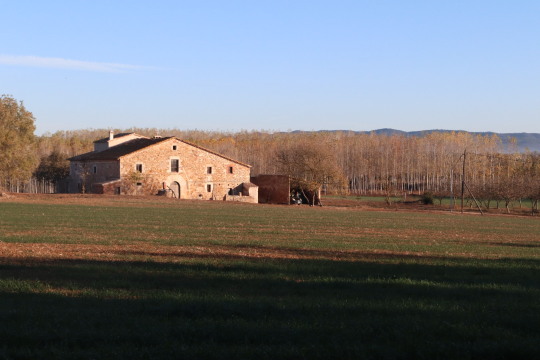
Réveillé de bonne heure pour partir tôt (et éviter les chasseurs). Je ne sais pas si c'est parce que je me suis éloigné de la côte, que je suis un peu en altitude ou bien si c'est tout simplement de saison mais, ce matin, il fait froid ! La première demi-heure pique un peu les mains puis le corps et l'air se réchauffent un peu.
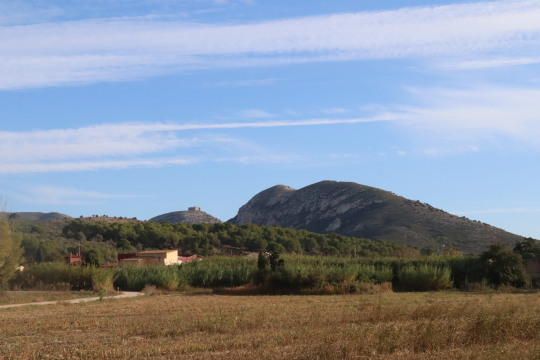
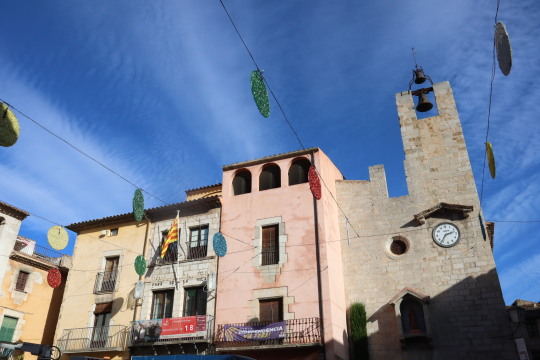
Je m'arrête pour déjeuner à Torroella de Montgrí. La cité est jolie et le château qui domine tout le pays donne bien envie d'y grimper. Ce sera pour une prochaine fois.
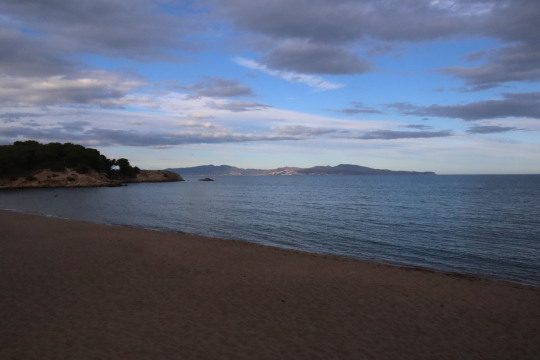
J'aperçoit enfin le cap de Creus. La frontière se rapproche. Je ne passerai pas par le cap mais je le salue de loin.

Depuis aujourd'hui, le chemin est bien balisé et il a un nom: Pirinexus. Les panneaux sont bien visible. C'est appréciable de ne pas hésiter en mettant le nez dans le GPS à chaque intersection. J'arrive en fin de journée à Saint Pere Pescador. J'y ai repéré un camping. Mais ce dernier est fermé, tout comme la dizaine d'autres autour. Et oui, en cette saison et à cette latitude il va falloir faire sans camping. Comme j'ai quand même besoin d'une douche et d'être au chaud pour la nuit, je pousse jusqu'à Castelló d'Empúries pour trouver un petit hôtel.
🎶
1 note
·
View note
Text

Best of British! Sort of. Republic F-84F Thunderstreaks - powered by the Wright J65, a licence-made copy of the UK-designed Armstrong Siddeley Sapphire.
@Tempest_books via X
#f-84f Thunderstreak#republic aviation#fighter bomber#aircraft#usaf#aviation#cold war aircraft#korean war aircraft
12 notes
·
View notes
Video
instagram
Coming Soon 🔥 1950’s Curtiss Wright J65 Jet Engine Nozzle Support turned table top fire pit 🔥 Limited to only 20 pieces 🔥 . . . #curtisswright #j65 #turbojet #armstrongsiddeley #usnavy #airforce #firepit #a4skyhawk #f11tiger #b57 #b57canberra #f84fthunderstreak #aviation #aviationlovers #aviationart #rockthesky #aircraftengine #aircraftengineer #aircraftmechanic #jetsetter #aircraftengine #jet #originalart #planegeek #avgeek #planeporn #functionalart #beachlife #bonfire (at Clinton Beach, Connecticut) https://www.instagram.com/p/CCxAFiMBc_2/?igshid=11840b3rxdcbj
#curtisswright#j65#turbojet#armstrongsiddeley#usnavy#airforce#firepit#a4skyhawk#f11tiger#b57#b57canberra#f84fthunderstreak#aviation#aviationlovers#aviationart#rockthesky#aircraftengine#aircraftengineer#aircraftmechanic#jetsetter#jet#originalart#planegeek#avgeek#planeporn#functionalart#beachlife#bonfire
1 note
·
View note
Photo

My love for seafood never dies! Back here at J65 for their Lobster Rock N Roll Buffet dinner. They have all things lobsters from Lobster Laksa, Lobster in Chili Crab Sauce, Grilled Lobster, Cold Lobster, Lobster Thermidor, Lobster Fried Rice, and many more. I've been here a couple times for business lunch and birthdays. The food was always good and fresh. Don't forget to try the Durian Pengat too. So yum!! . They have different theme everyday like Salmon Showdown Buffet, Asian Seafood Buffet and Seafood BBQ & Beer Buffet. So make sure you check with them when making reservation. #mediatasting #hoteljentanglin #j65 #lobsterbuffet (at Hotel Jen Tanglin Singapore by Shangri-La) https://www.instagram.com/p/B1-__6wB9V3/?igshid=17u9xapr8nv35
0 notes
Text
i finally finished getting all the cards 😭
it turns out the last one i was missing was this enemy from the grand farm....

#msc#i really wasn't expecting this i thought it was just gonna be more horses#like i was walking around like where are the horses? and then this guy popped up and i got jumpscared ADFLGJ:LK:HJFGDFH$%j65#it was also really annoying to fight because i kept missing the hitboxes and i was like...can i please do some damage</3#anyways if i were to rate the enemies this guy would get maybe like a 6/10.#on the other hand the two guys in a trenchcoat is a solid 10/10 they are so funny
5 notes
·
View notes
Text

Lockheed F-104G aircraft lined up at Ingolstadt Manching Airport Germany. | Photo: Unbekannter Autor
FLIGHTLINE: 116 - LOCKHEED F-104 STARFIGHTER
The F-104 was designed as a simple, lightweight interceptor with maximum altitude and climb performance.
Springing from the mind of Kelly Johnson and his team at Lockheed, the F-104 was developed in the early 1950s as a blindingly fast, high flying interceptor to engage Soviet bombers. Based on interviews with pilots returning from the Korean war, Johnson wanted to reverse the trend in the USAF toward increasingly heavy and complex fighters. The USAF seemed to agree, issuing a operational requirement on 5 November 1952 for a lightweight day fighter to supplement, if not ultimately replace, the F-100 Super Sabre. In addition to the Lockheed design, which had been given the internal designation L-246, Republic Aviation proposed their AP-55, derived from the XF-91 Thunderceptor, North American advanced the NA-212, which was developed from the F-100, and Northrop submitted their N-102 Fang.
Lockheed was awarded a development contract on 12 March 1953 for two prototypes of the newly-christened XF-104. The initial design had changed in the interim, with data gleaned from the and X-7 programs being incorporated into the new interceptor. The XF-104 now featured a long tubular fuselage, dominated by a single massive J79 turbojet and featuring small wings so thin that they needed covers during maintenance, lest ground crew cut themselves. The V-tail and variable-position horizontal stabilizers had given way to a single T-tail with an all-moving stabilizer.

Schematics of the F-104. | Illustration: Bagera3005 @ DeviantArt
The first flight of XF-104 #1 took place in March 1954, powered by a Wright J65 engine as the J79 was facing issues in development. The XF-104 had small, trapezoidal wings like the X-3 and X-7, and as such the fuel and landing gear would need to be contained in the fuselage. Because the wings and tail were nearly the same size, the wings were given a 10° anhedral to counteract a tendency to Dutch Roll. The high T-tail led to Lockheed installing a unique downward-firing ejection seat, so as to not injure the pilot if he struck the tail. This feature was removed in the production F-104 as ejection seat technology improved. Both XF-104s were lost during the test program, though enough data was acquired that the production F-104A featured numerous improvements and modifications.
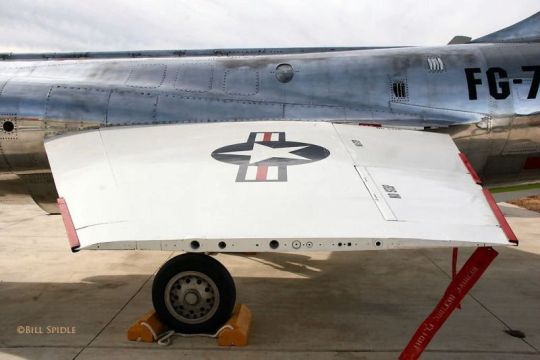
F-104A showing leading and trailing edge covers. | Photo: Bill Spidle
The Starfighter saw service in the USAF from 1958 until 1969, though use continued with the Puerto Rican Air National Guard until 1975. The plane was widely exported, serving in the air forces of 14 other nations, as well as NASA. Canada, Italy and Japan license-built their own copies, with the CF-104 being modified to perform nuclear strike and recon roles, the F-104S designed to fire AIM-7 Sparrow missile, and the F-104J, which resembled the F-104G, but retained the original F-104A’s interceptor-only role.
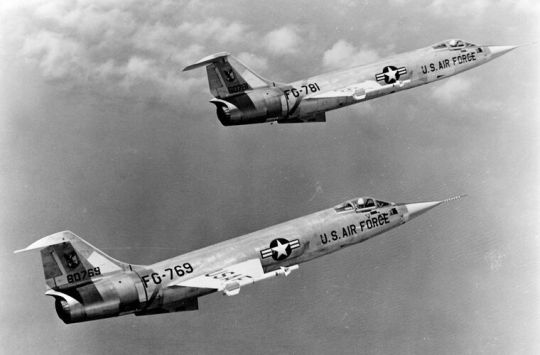
A pair of USAF F-104s, circa 1960, with Buzz Numbers visible on the aft fuselage. | Photo: USAF

An F-104 shooting down a QF-80 drone during a test. | Gif from a USAF film
The F-104C was a fighter bomber variant developed for the USAF's Tactical Air Command (TAC). The radar was improved, and two pylons were added to each wing, along with one under the fuselage, allowing the plane to carry rockets and conventional bombs, along with a single Mk.28 or Mk.43 nuclear weapon. The C model was also equipped with aerial refueling equipment. TAC's F-104C served in Vietnam from 1965 through 1967 before being supplanted by the F-4. Starfighters under the direction of EC-121 Warning Stars shot down 25 MiGs during the war, and 15 F-104s were lost to SAMs, AAA, engine failure, one air-to-air kill by a PLAN J-6, and one mid-air collision.
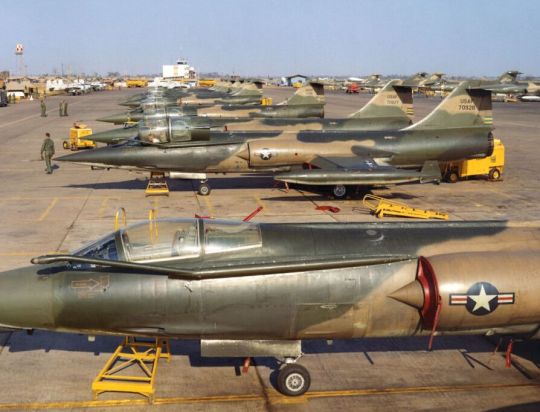
TAC F-104C Starfighters from the 435th Tactical Fighter Squadron, 479th Tactical Fighter Wing, at Udorn Royal Thai Air Force Base in 1965. | Photo: USAF
The F-104G was the definitive variant, and 1,127 were produced by Lockheed, Canadair, and a consortium of Messerschmidt/MBB, Fiat, Fokker and S.A.B.C.A. The type featured a strengthened fuselage, wing, and empennage structures; the larger vertical fin with fully powered rudder as used on the two-seat versions; fully powered brakes, a new anti-skid system, and larger tires; revised flaps for improved combat maneuvering; and a larger braking chute. The G model was also a multi-role aircraft, with 7 hardpoints under the wing and fuselage allowing carriage of AIM-9 Sidewinders, unguided bombs and rockets, and fuel tanks.
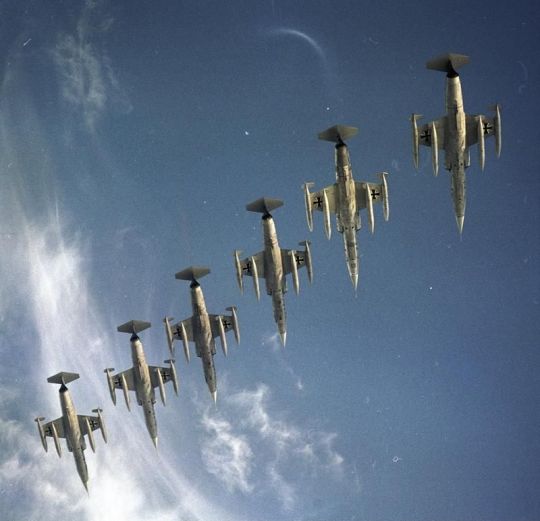
A formation of F-104Gs from the air arm of the German Navy in 1965. | Photo: Marineflieger
It was this multi-role aspect that interested the international community, and the so-called ��Deal of the Century” was struck (with bribes greasing the wheels along the way), allowing Lockheed’s new mount to replace a large number of aging first-generation jets. West Germany acquired 915 Starfighters, with 151 going to the Marineflieger and the rest to the Luftwaffe. Though an adequate fighter-bomber, the F-104 design was optimized for high-speed, high-altitude flight, and the adaptations to low-altitude flight were not entirely effective. The plane quickly gained a reputation as being accident-prone, with 270 aircraft lost in West German service and 110 pilots killed. The press dubbed the plane Witwenmacher (‘widowmaker’), and the running joke being “How do you get an F-104 for cheep? Buy a plot of land in West Germany and wait.”. Still, the plane soldiered on in Luftwaffe service, surviving past reunification and being finally retired in 1991.
NASA acquired F-104As in 1963, which were then modified with the addition of a Rocketdyne AR2-3 rocket engine in an angled housing beneath the tail fin, as well as hydrogen peroxide reaction control thrusters, and were used to train pilots for the X-15 and X-20 DynaSoar. One of these NF-104As was lost during a test flight by Chuck Yeager, which was depicted in the book The Right Stuff, as well as the film that was adapted from it.

A NASA NF-104A executing a rocket-assisted zoom climb. | Photo: USAF
Three F-104G aircraft were also acquired by NASA in 1963 for use as high-speed chase aircraft under the designation F-104N. One of these aircraft was famously lost in a mid-air collision with the XB-70A Valkyrie bomber, killing both Joe Walker, pilot of the F-104, and Carl Cross, co-pilot of the XB-70. The other aircraft remained in NASA service until 1994, making it the last Starfighter in US service.

A formation of USAF and NASA aircraft in 1966, From foreground to background they are a T-38A, F-4B, XB-70A, F-104N and YF-5A. The flight had been set up at the behest of General Electric, which manufactured the engines in all 5 craft. | Photo: USAF
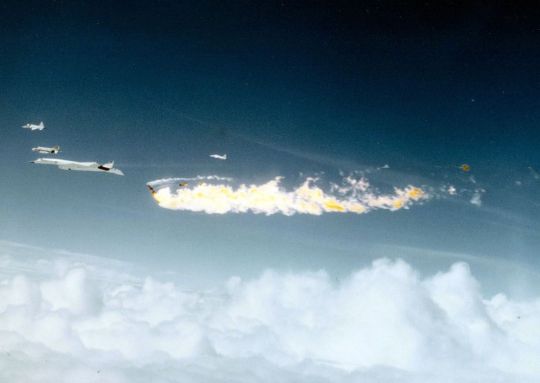
The immediate aftermath of the collision. Investigators determined that Joe Walker in the F-104 lost sight of the XB-70 and drifted into the larger plane's wake vortex, which catapulted the Starfighter across the Valk's back. | Photo: USAF
The F-104, in various models, served with the armed forces of 15 nations, along with NASA and at least one civilian demo team. Italy was the last user, with the F-104S being retired in 2004.
#aircraft#aviation#avgeek#cold war#airplanes#cold war history#airplane#coldwar#usaf#aviation history#Lockheed#lockheed f-104#starfighter#vietnam war#f104#f 104
68 notes
·
View notes
Text

B-17G with a new centerline mount J65 turbojet.
@IL_wheels via X
#b 17 flying fortress#boeing aviation#bomber#aircraft#usaf#aviation#cold war aircraft#aviation military pics#aviation military#military aviation#military aircraft
8 notes
·
View notes
